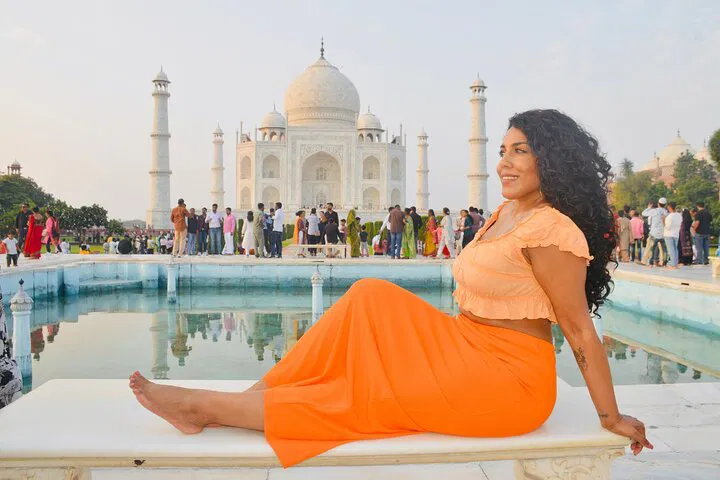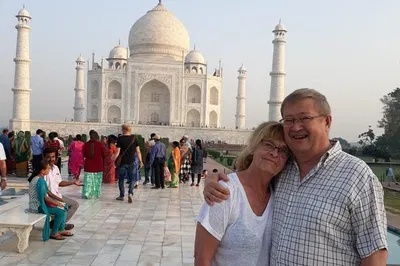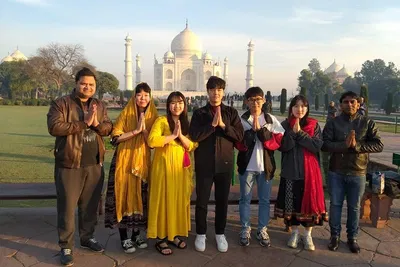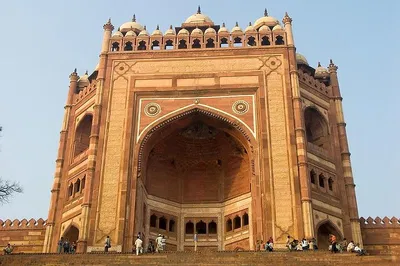Incredible India: 14-Day Golden Triangle & Rajasthan Tour
8640
Overview
Experience the magic of India with the 14 Days Private Golden Triangle Tour with Incredible Rajasthan! This special trip lets you take your time in some of the prettiest cities in North India. You'll see Delhi, Agra, Jaipur, and more! Get ready to learn about Indian culture and history from friendly local guides in each city.
What can you expect on this adventure? You'll visit famous places like the India Gate and Qutub Minar in Delhi. In Agra, get ready to see the amazing Taj Mahal at sunrise! You'll also explore big forts, beautiful palaces, and busy markets in Rajasthan. See the Amber Fort in Jaipur and the Mehrangarh Fort in Jodhpur.
This tour includes comfy rides in a private car with air conditioning. You'll also have local guides to show you around. Enjoy hotel pick-up and drop-off, plus bottled water to keep you cool. You'll even get a battery bus ride to the Taj Mahal! This tour gives you personal care and attention. It's a great way to see the best of North India!
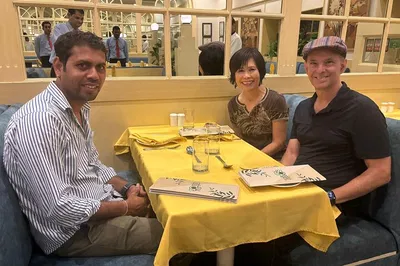
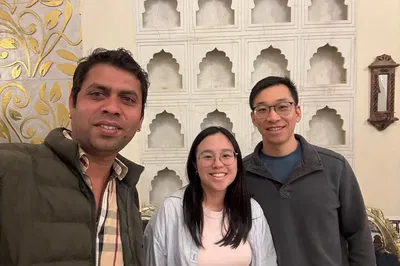
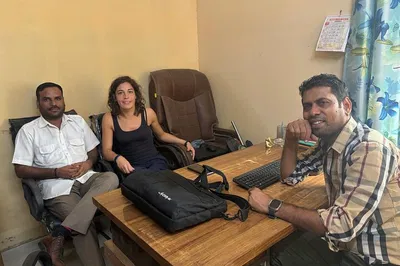

Highlights
See the Taj Mahal: Visit one of the most famous buildings in the world at sunrise.
Travel in Comfort: Enjoy a private car with air conditioning and a friendly driver.
Learn from Local Experts: Get to know each city with the help of knowledgeable local guides.
Explore Rajasthan's Forts and Palaces: Discover the Amber Fort, Mehrangarh Fort, and more!
Sentiment Analysis
Customers really enjoyed the well-organized tour of the Golden Triangle and Rajasthan, especially appreciating the drivers, guides, and hotel accommodations.

Customers loved having a dedicated and safe driver.
Many tourists said that the tour was organized well.
Travelers enjoyed the friendly and informative guides.
Several reviewers said that the hotels were very good.
Some travelers want the tour to include lunch and dinner.
Few travelers mention the need to pay extra for monument entrance fees.
The Journey
Gurudwara Bangla Sahib
Gurudwara Bangla Sahib is a prominent Sikh shrine in Delhi, famed for its healing waters. In 1664, the eighth Sikh Guru visited and is said to have cured smallpox and cholera by distributing water from the tank. The sarovar (water tank) within the Gurudwara is believed to possess medicinal properties and continues to draw devotees seeking blessings and healing.
Agrasen ki Baoli
Agrasen ki Baoli is an ancient stepwell in Delhi, a protected monument that plunges 60 meters deep and stretches 15 meters wide. This architectural marvel served as a water reservoir and a communal gathering place, showcasing intricate stonework and offering a cool respite from the city's heat. Its historical significance and unique structure make it a compelling visit.
Qutub Minar
Qutub Minar, a UNESCO World Heritage site, is a towering 73-meter-tall minaret in Delhi, built in 1193 by Qutub-ud-din Aibak, founder of the Delhi Sultanate. Its Indo-Islamic architecture, influenced by the Minaret of Jam, and its intricate carvings stand as a testament to medieval craftsmanship and a symbol of Delhi's rich history.
Lotus Temple
The Lotus Temple is a modern architectural marvel in Delhi, renowned for its distinctive flower-like shape. Completed in 1986, this Baháʼí House of Worship welcomes people of all faiths. Its serene atmosphere, striking design, and universal appeal make it a must-see landmark and a symbol of unity.
India Gate
India Gate, a prominent war memorial in Delhi, stands as a tribute to the soldiers of British India who sacrificed their lives in various wars. This iconic arch, set against the backdrop of the Rajpath, also serves as a popular gathering spot, offering lush lawns for picnics and a space for national remembrance.
Parliament House
Parliament House (Sansad Bhavan) in Delhi is the seat of the Indian Parliament, comprising the Lok Sabha and Rajya Sabha. Its circular design, inspired by the Ashoka Chakra, and its grand architecture reflect India's democratic ideals. While access is restricted, driving past this landmark offers a glimpse into the heart of Indian governance.
Jama Masjid
Jama Masjid, also known as Masjid-i-Jehan-Numa, is one of India's largest mosques, built by Mughal Emperor Shah Jahan between 1650 and 1656. This architectural masterpiece, with its grand courtyard, towering minarets, and intricate marble inlays, stands as a testament to Mughal grandeur and a sacred space for prayer and reflection in the heart of Old Delhi.
Humayun's Tomb
Humayun's Tomb in Delhi, a UNESCO World Heritage Site, is a magnificent Mughal-era mausoleum commissioned in 1558 by Empress Bega Begum for her husband, Emperor Humayun. This precursor to the Taj Mahal showcases exquisite Persian architectural influences, intricate carvings, and serene gardens, offering a glimpse into Mughal royalty and artistic vision.
Chandni Chowk
Chandni Chowk, the vibrant heart of Old Delhi, is a bustling marketplace brimming with spices, dried fruits, silver jewelry, and colorful saris. Its narrow lanes teem with tiny shops selling essential oils, stationery, and traditional Indian sweets. Adjacent to the Mughal-era Red Fort, Chandni Chowk offers an immersive sensory experience and a taste of Delhi's historical charm.
Road to Agra
The journey from Delhi to Agra is an adventure in itself. The 222km drive takes approximately 4 hours through a landscape that gradually transitions from urban sprawl to the rustic beauty of the Indian countryside. Anticipate the shift from the modern cityscape to a landscape that foreshadows the historical marvels awaiting in Agra.
Agra Fort
Agra Fort, a UNESCO World Heritage Site, is a magnificent red sandstone fortress steeped in Mughal history. Once the imperial residence of emperors like Akbar, Shah Jahan, and Aurangzeb, it showcases a blend of architectural styles and offers stunning views of the Taj Mahal. Its historical significance and impressive structure make it a must-visit destination in Agra.
Tomb of I'timād-ud-Daulah (Baby Taj)
The Tomb of I'timād-ud-Daulah, often called the "Baby Taj" or "Jewel Box," is an exquisite Mughal mausoleum in Agra, predating the Taj Mahal. This delicate marble structure, commissioned by Nur Jahan for her father, is renowned for its intricate pietra dura inlay work, serene gardens, and delicate artistry, offering a glimpse into the refined aesthetic of Mughal craftsmanship.
Taj Mahal Sunset View Point
The Taj Mahal Sunset View Point offers a serene and less crowded perspective of the iconic monument. From across the river, witness the Taj Mahal bathed in the warm hues of the setting sun, creating a magical and unforgettable vista. Capture the beauty and majesty of this architectural wonder in a peaceful and picturesque setting.
Mehtab Bagh
Mehtab Bagh, a Mughal-era garden in Agra, provides stunning views of the Taj Mahal across the Yamuna River. Restored by Emperor Babur, its lush greenery, fountains, and pavilions offer a tranquil oasis. Explore the gardens, enjoy panoramic views, and experience the serene beauty of this historical landscape with the majestic Taj Mahal as its backdrop.
Taj Mahal (Sunrise)
The Taj Mahal at sunrise is an ethereal experience. Witness the ivory-white marble mausoleum, commissioned by Shah Jahan for his beloved wife Mumtaz Mahal, bathed in the soft, golden light of dawn. The tranquil atmosphere, combined with the monument's breathtaking beauty, creates a memory that will last a lifetime. It is an experience to marvel at the monument when the day is starting.
Fatehpur Sikri
Fatehpur Sikri, the "City of Victory," is a UNESCO World Heritage site built by Emperor Akbar in the late 16th century. This abandoned city, with its cohesive architectural style, features grand palaces, courtyards, and the Jama Masjid, one of India's largest mosques. Explore its historical significance and marvel at its well-preserved Mughal architecture.
Chand Baori
Chand Baori, located in Abhaneri, Rajasthan, is one of India's largest and deepest stepwells, descending approximately 30 meters into the ground. This ancient architectural marvel features thousands of precisely arranged steps, showcasing the engineering prowess of a bygone era. Its dramatic structure and historical importance make it a captivating sight.
Jaipur Hotel
Upon arrival in Jaipur, experience the warm hospitality of Rajasthan as you check in at your hotel. Take a moment to unwind and prepare for an immersive exploration of the city's rich culture and historical sites.
Panna Meena ka Kund
Panna Meena ka Kund is a historic stepwell near Amber Palace in Jaipur, known for its symmetrical staircases and architectural beauty. This ancient water reservoir served as a communal gathering place and offers a glimpse into the region's cultural heritage. Its intricate design and scenic setting make it a unique and picturesque spot.
Amber Fort
Amber Fort, once the capital of Rajasthan, is a majestic fortress built by Raja Man Singh I. Explore its opulent palaces, courtyards, and intricate artwork, and marvel at the Maota Lake below. Its artistic elements, ramparts, and series of gates offers a glimpse into royal life and the artistic prowess of the region.
Jal Mahal
Jal Mahal, the "Water Palace," is a picturesque palace floating on Man Sagar Lake in Jaipur. Renovated in the 18th century by Maharaja Jai Singh II, this architectural gem offers a stunning visual spectacle. Its serene setting and scenic beauty attract visitors seeking a tranquil and photogenic landmark.
City Palace, Jaipur
City Palace of Jaipur, originally the administrative and ceremonial seat of the Maharaja, is now a museum housing the Maharaja Sawai Man Singh II Museum. Explore its courtyards, museums, and royal residences to witness the rich history and cultural heritage of Jaipur's royal family. Discover an impressive collection of weapons, costumes, and artifacts that highlight the grandeur of Rajputana.
Jantar Mantar, Jaipur
Jantar Mantar, a UNESCO World Heritage Site in Jaipur, is an astronomical observatory built in 1734 by Sawai Jai Singh II. Its collection of nineteen architectural astronomical instruments allows for naked-eye observation of celestial positions. Explore this unique site and discover the scientific curiosity of the Rajput king.
Hawa Mahal
Hawa Mahal, the "Palace of Winds," is a distinctive five-story pyramidal monument made of red and pink sandstone. Built in 1799 by Sawai Pratap Singh, its intricate façade features numerous small windows that allowed royal women to observe street festivities unseen. Admire its unique architecture and capture its beauty as you explore Jaipur.
Road to Bikaner
After breakfast, depart from Jaipur and journey to Bikaner, a city nestled in the Thar Desert. Upon arrival, check in at your hotel and prepare for an exploration of this historically rich city. From Bikaner, head out for some local sightseeing, soaking in the unique ambiance and cultural attractions the desert city has to offer.
Junagarh Fort
Junagarh Fort stands as a testament to Bikaner's historical grandeur. Unlike most forts, it's not built on a hill. Despite being in the arid Thar Desert, it boasts marvelous architecture and intricate carvings that captivate visitors. Explore its palaces, courtyards, and museums to experience the opulence of Bikaner's royal past.
Road to Jaisalmer via Karni Mata Temple
After breakfast, embark on a scenic drive from Bikaner to Jaisalmer, with a stop at the unique Karni Mata Temple, known as the "Temple of Rats." This extraordinary temple, dedicated to the deity Karni Mata, houses thousands of revered rats. Continue to Jaisalmer, anticipating the golden city that awaits.
Jaisalmer
Jaisalmer, the "Golden City," is an exotic desert fortress in Rajasthan's Thar Desert. Rising to prominence due to its strategic location, it's now renowned for its 12th-century fort, ornate havelis, and vibrant culture. Explore the narrow, medieval lanes, discover merchant-built houses, and immerse yourself in the desert landscape.
Jaisalmer Fort
Jaisalmer Fort, the "Golden Fort," is a living fort, with local people still residing within its walls. Explore its narrow lanes, ancient temples, and vibrant marketplaces, and experience the unique atmosphere of this medieval citadel. Marvel at the intricate architecture and discover the stories of its residents.
Patwon Ki Haveli
Patwon Ki Haveli is a cluster of five ornate residences built by wealthy Jain merchants in the 19th century. These grand structures, adorned with intricate jaalis and elaborate façades, showcase the wealth and artistic prowess of Jaisalmer's merchant community. Explore each haveli and admire the craftsmanship of the past.
Salim Singh Ki Haveli
Salim Singh Ki Haveli, built in 1815, is a unique mansion known for its distinctive peacock-shaped roof and elaborate carvings. Once the residence of Salim Singh, the prime minister of the kingdom, it stands as a testament to the architectural ingenuity and artistic flair of Jaisalmer's historical elite.
Nathmal ki Haveli
Nathmal ki Haveli, a late 19th-century mansion, was once the residence of Jaisalmer's prime minister. Built by two jeweller brothers, its distinctive architecture features intricate carvings and a unique blend of styles. Explore its façade and marvel at the symmetry and craftsmanship of this architectural gem.
Gadisar Lake
Gadisar Lake, constructed by Raja Rawal Jaisal and reconstructed by Maharawal Gadsi Singh in 1367 AD, is a serene oasis surrounded by temples and ghats. Take a boat ride on the lake, explore the surrounding structures, and enjoy the tranquil ambiance of this historical reservoir.
Road to Jodhpur
In the early morning, depart from Jaisalmer and drive to Jodhpur, the "Blue City." Upon arrival, check in at your hotel and prepare to explore this historic city. Visit the Clock Tower, wander through the local markets, and savor a delicious dinner at a restaurant of your choice. Settle in for an overnight stay, ready to discover Jodhpur's charms.
Clock Tower, Jodhpur
The Clock Tower in Jodhpur, built during the reign of Maharaja Sardar Singh, is a prominent landmark in the heart of the city. Explore the surrounding Sardar Market, a bustling marketplace filled with textiles, handicrafts, and spices. Immerse yourself in the vibrant atmosphere and experience the local culture.
Mehrangarh Fort
Mehrangarh Fort, a majestic 15th-century fortress, towers over the Blue City of Jodhpur. Now a museum, it displays weapons, paintings, and royal palanquins. Explore its ramparts, courtyards, and galleries to discover the history and grandeur of Jodhpur's royal past. Enjoy panoramic views of the city from this imposing fortress.
Umaid Bhawan Palace
Umaid Bhawan Palace, one of the world's largest private residences, is a magnificent palace showcasing Indo-Art Deco architecture. Part of the palace is a museum displaying royal artifacts. Experience the luxury and opulence of this historical landmark, built with golden-yellow sandstone.
Jaswant Thada
Jaswant Thada, often called the "Taj Mahal of Jodhpur," is a splendid marble cenotaph built in 1899 in memory of Maharaja Jaswant Singh II. Explore its intricately carved marble sheets, admire the well-maintained gardens, and experience the serene atmosphere of this royal cremation ground.
Udaipur Hotel
Upon arrival at Udaipur, check in at your hotel. Get settled in and prepare for a relaxing overnight stay, ready to explore the beauty and charm of the "City of Lakes".
Lake Pichola
Lake Pichola is a picturesque artificial lake in Udaipur, perfect for sightseeing and boating. Take a private boat ride around the lake, stopping at the Jagmandir Palace island. Enjoy the stunning views of Udaipur's palaces, temples, and ghats reflected in the serene waters of this enchanting lake.
City Palace, Udaipur
The City Palace of Udaipur, located on the banks of Lake Pichola, is a magnificent complex showcasing a blend of architectural styles. Explore its courtyards, museums, and royal residences to witness the rich history and cultural heritage of Udaipur's royal family. Enjoy the panoramic city views and experience the royal ambiance of this historic palace.
Jagdish Temple
Jagdish Temple, located in the City Palace complex of Udaipur, is one of the city's most famous temples. Built in the Indo-Aryan style of architecture, this temple features intricate carvings, ornate pillars, and a towering spire. Experience the spiritual ambiance and admire the architectural beauty of this sacred shrine.
Guided Tours and Transportation
Enjoy tours with knowledgeable guides and comfortable private transportation, allowing you to learn about the facts and details of each attraction. If you prefer to skip a particular visit, you have the flexibility to do so and move to the next destination, tailoring your itinerary to your interests and preferences.
Pushkar Hotel
Upon arrival at Pushkar, check in at your hotel. Settle in and prepare for a relaxing overnight stay, ready to explore the spiritual and cultural ambiance of this sacred town.
Brahma Ghat, Pushkar
After visiting the Brahma Temple, head towards Brahma Ghat, where families offer prayers for happiness and pay tribute to the departed souls. Brahma Ghat is renowned for its picturesque setting and the opportunity to participate in blessings rituals. Capture the essence of Pushkar's spiritual heritage at this sacred site.
Road to Delhi
After Sightseeing, Check-out from the Hotel and drive to Delhi.
Delhi Airport
After breakfast, in good time Checkout form the hotel and according to your pre-booked flight time our driver will drop you at Delhi airport for your onward journey with some beautiful & precious memories.
Know Before You Go
This tour includes 13 nights of comfy places to stay if you pick the hotel option. Travel around in a private car with air conditioning and a driver. You'll also get a battery bus ride to the Taj Mahal. All the sightseeing is with local guides. Pick-up and drop-off at your hotel or the airport are included. You'll also get bottled water. Breakfast is included if you pick the hotel option. What's not included: tips, personal spending, entrance fees, travel insurance, plane or train tickets, lunch, and dinner.
Hot Tip
Many travelers found that having a driver made the trip stress-free. Also, some tourists said that each city has something special to offer, so try to learn as much as you can from your guide!
